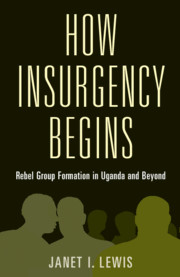Book contents
- How Insurgency Begins
- Cambridge Studies in Comparative Politics
- How Insurgency Begins
- Copyright page
- Contents
- Figures
- Tables
- Acknowledgments
- Part I Rethinking How Armed Conflicts Begin
- Part II Uganda and Beyond
- 3 Context and Initial Conditions
- 4 The Rebels
- 5 Civilians
- 6 The State
- Part III Implications
- Book part
- References
- Index
- Series page
3 - Context and Initial Conditions
from Part II - Uganda and Beyond
Published online by Cambridge University Press: 18 September 2020
- How Insurgency Begins
- Cambridge Studies in Comparative Politics
- How Insurgency Begins
- Copyright page
- Contents
- Figures
- Tables
- Acknowledgments
- Part I Rethinking How Armed Conflicts Begin
- Part II Uganda and Beyond
- 3 Context and Initial Conditions
- 4 The Rebels
- 5 Civilians
- 6 The State
- Part III Implications
- Book part
- References
- Index
- Series page
Summary
This chapter provides context and description about rebel group formation in Uganda since 1986. Doing so supports several theoretical assertions from Chapter 2 about the strategic approach of initial rebel leaders and the initial conditions they typically face in weak states. The chapter first sketches the key events that led to Uganda’s exceedingly low state capacity in 1986, the year in which this book’s analyses of rebel group formation begins. It then describes the nascent Ugandan rebel leaders’ initial stated goals, their initial lack of strong ideology or material and organizational endowments, and the clandestine nature of their early days. It shows that in Uganda, it was small, secretive groups of rebel entrepreneurs – not large groups of intensely aggrieved, protesting citizens – who initially formed groups that aimed to use violence to challenge the state. The chapter also checks the relevance of these initial conditions of rebel group formation beyond the borders of Uganda, in several other Eastern and Central African states.
Keywords
Information
- Type
- Chapter
- Information
- How Insurgency BeginsRebel Group Formation in Uganda and Beyond, pp. 63 - 85Publisher: Cambridge University PressPrint publication year: 2020
